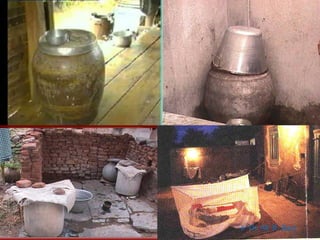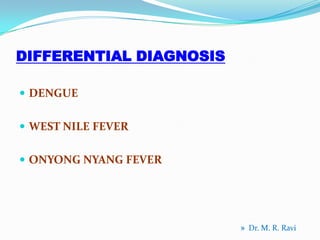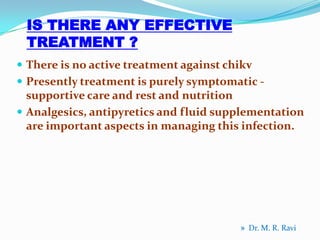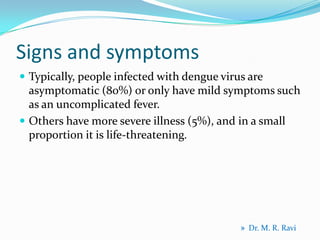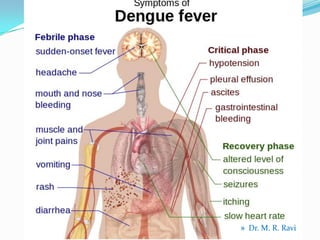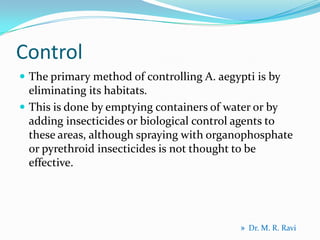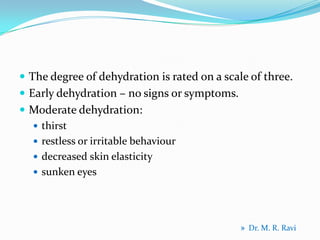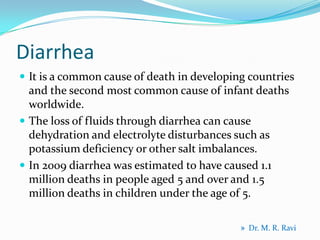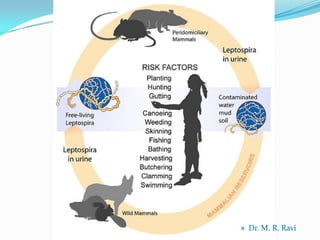Monsoon diseases
- 1. » Dr. M. R. Ravi
- 2. » Dr. M. R. Ravi Dengue fever Dengue fever is an infectious tropical disease caused by the dengue virus.
- 3. » Dr. M. R. Ravi Symptoms include fever, headache, muscle pains joint pains, a characteristic skin rash that is similar to measles.
- 4. » Dr. M. R. Ravi
- 5. » Dr. M. R. Ravi In a small proportion of cases the disease develops into the life- threatening dengue hemorrhagic fever, resulting in bleeding, low levels of blood platelets and blood plasma leakage, or into dengue shock syndrome, where dangerously low blood pressure occurs.
- 6. » Dr. M. R. Ravi Dengue is transmitted by several species of mosquito within the genus Aedes, principally A. aegypti and A. albopictus. The virus has four different types; infection with one type usually gives life long immunity to that type, but only short-term immunity to the others. Subsequent infection with a different type increases the risk of severe complications.
- 7. » Dr. M. R. Ravi Control and prevention As there is no commercially available vaccine, prevention is sought by reducing the habitat and the number of mosquitoes and limiting exposure to bites.
- 8. Chikungunya is a relatively rare form of viral fever ("debilitating non- fatal viral illness." ) caused by an alphavirus that is spread by mosquito bites from the Aedes aegypti and Aedes albopictus mosquito.
- 9. » Dr. M. R. Ravi
- 10. » Dr. M. R. Ravi EPIDEMIOLOGICAL TRIAD AGENT HOST ENVIRONMENT VECTOR
- 11. » Dr. M. R. Ravi Aedes aegypti » Dr. M. R. Ravi
- 12. » Dr. M. R. Ravi Aedes albopictus » Dr. M. R. Ravi
- 13. » Dr. M. R. Ravi Mosquito proboscis (scanning electron microscopy) » Dr. M. R. Ravi
- 14. » Dr. M. R. Ravi Mosquito mouth parts (scanning electron microscopy) » Dr. M. R. Ravi
- 15. » Dr. M. R. Ravi» Dr. M. R. Ravi
- 16. » Dr. M. R. Ravi AEDES MOSQUITOES Household container breeders Breeds in clean water In all stored water for drinking, washing and bathing Rainwater collected in unused materials like coconut shells, mud pots, plastic cups, tyres etc
- 17. BREEDING SOURCES » Dr. M. R. Ravi
- 18. » Dr. M. R. Ravi
- 19. » Dr. M. R. Ravi
- 20. » Dr. M. R. Ravi
- 21. AEDES MOSQUITOES Aggressive day time Bite Major period of activity – sunrise and sunset
- 22. » Dr. M. R. Ravi ENVIRONMENT Population explosion Deforestation Global warming Floods Competition for food fast movement of population
- 23. » Dr. M. R. Ravi ENVIRONMENT Emergence of world as single village Unplanned urbanization Inadequacy of sanitation, Improper disposal of garbage and pollution of aquatic systems Development of resistance in vectors to insecticides
- 24. » Dr. M. R. Ravi TRANSMISSION This virus is transmitted only by mosquitoes The mosquito picks up the virus from an infected person during the viraemic period – within five days from the day of starting of symptoms An infected mosquito will remain infected all its life span and can transmit the virus each time it bites An infected person cannot spread the infection directly to other persons
- 25. » Dr. M. R. Ravi SYMPTOMS Fever Which Can Reach 39 C, (102.2 F) Petechial or Maculopapular Rash Usually Involving the Limbs and Trunk Arthralgia or Arthritis Affecting Multiple Joints Which Can Be Debilitating. Headache, Conjunctival Injection and Slight Photophobia.
- 26. DIAGNOSIS The diagnostic tests include detection of antigens or antibodies in the blood, using ELISA (or EIA - enzyme immunoassay) polymerase chain reaction (PCR).
- 27. » Dr. M. R. Ravi DIFFERENTIAL DIAGNOSIS DENGUE WEST NILE FEVER ONYONG NYANG FEVER
- 28. » Dr. M. R. Ravi COMPLICATIONS Symptoms are generally self-limiting and last for 1–10 days. Arthralgia (joint pain) may persist for months or years. In some patients, minor hemorrhagic signs such as epistaxis or gingivorrhagia have also been described
- 29. » Dr. M. R. Ravi IS THERE ANY EFFECTIVE TREATMENT ? There is no active treatment against chikv Presently treatment is purely symptomatic - supportive care and rest and nutrition Analgesics, antipyretics and fluid supplementation are important aspects in managing this infection.
- 30. » Dr. M. R. Ravi TREATMENT Self-limiting and Will Resolve With Time. No Specific Treatment for Chikungunya. Supportive or Palliative Medical Care With Anti- inflammatories
- 31. » Dr. M. R. Ravi TREATMENT Vaccine Trials Were Carried Out in 2000, the Project Was Discontinued and There Is No Vaccine Currently Available. Supportive care with rest is indicated during the acute joint symptoms.
- 32. » Dr. M. R. Ravi TREATMENT Movement and mild exercise tend to improve stiffness and morning arthralgia, but heavy exercise may exacerbate rheumatic symptoms. aspirin and nonsteroidal antiinflammatory drugs, chloroquine phosphate (250 mg/day) has given promising results.
- 33. » Dr. M. R. Ravi Signs and symptoms Typically, people infected with dengue virus are asymptomatic (80%) or only have mild symptoms such as an uncomplicated fever. Others have more severe illness (5%), and in a small proportion it is life-threatening.
- 34. » Dr. M. R. Ravi Signs and symptoms The incubation period (time between exposure and onset of symptoms) ranges from 3–14 days, but most often it is 4–7 days. Children often experience symptoms similar to those of the common cold and gastroenteritis (vomiting and diarrhea) and have a greater risk of severe complications, though initial symptoms are generally mild but include high fever.
- 35. » Dr. M. R. Ravi» Dr. M. R. Ravi
- 36. » Dr. M. R. Ravi Course of Dengue illness » Dr. M. R. Ravi
- 37. » Dr. M. R. Ravi Prevention There are no approved vaccines for the dengue virus. Prevention thus depends on control of and protection from the bites of the mosquito that transmits it.
- 38. » Dr. M. R. Ravi Prevention The World Health Organization recommends an Integrated Vector Control program consisting of five elements: (1) Advocacy, social mobilization and legislation to ensure that public health bodies and communities are strengthened, (2) collaboration between the health and other sectors (public and private),
- 39. » Dr. M. R. Ravi Prevention (3) an integrated approach to disease control to maximize use of resources, (4) evidence-based decision making to ensure any interventions are targeted appropriately and (5) capacity-building to ensure an adequate response to the local situation.
- 40. » Dr. M. R. Ravi Control The primary method of controlling A. aegypti is by eliminating its habitats. This is done by emptying containers of water or by adding insecticides or biological control agents to these areas, although spraying with organophosphate or pyrethroid insecticides is not thought to be effective.
- 41. » Dr. M. R. Ravi Control Reducing open collections of water through environmental modification is the preferred method of control, given the concerns of negative health effect from insecticides and greater logistical difficulties with control agents. People can prevent mosquito bites by wearing permethroid impregnated clothing that fully covers the skin, using treated mosquito netting while resting, and/or the application of insect repellent.
- 42. » Dr. M. R. Ravi Diarrhea Diarrhea (AmE) (or diarrhoea) (BrE) is the condition of having three or more loose or liquid bowel movements per day. The most common cause is gastroenteritis.
- 43. » Dr. M. R. Ravi Diarrhoeal disease Key facts Diarrhoeal disease is the second leading cause of death in children under five years old. It is both preventable and treatable. Each year diarrhoea kills around 760 000 children under five.
- 44. » Dr. M. R. Ravi Diarrhoeal disease Key facts A significant proportion of diarrhoeal disease can be prevented through safe drinking- water and adequate sanitation and hygiene.
- 45. » Dr. M. R. Ravi Diarrhoeal disease Key facts Globally, there are nearly 1.7 billion cases of diarrhoeal disease every year. Diarrhoea is a leading cause of malnutrition in children under five years old.
- 46. » Dr. M. R. Ravi Dehydration The most severe threat posed by diarrhoea is dehydration. During a diarrhoeal episode, water and electrolytes (sodium, chloride, potassium and bicarbonate) are lost through liquid stools, vomit, sweat, urine and breathing. Dehydration occurs when these losses are not replaced.
- 47. » Dr. M. R. Ravi The degree of dehydration is rated on a scale of three. Early dehydration – no signs or symptoms. Moderate dehydration: thirst restless or irritable behaviour decreased skin elasticity sunken eyes
- 48. » Dr. M. R. Ravi Dehydration Severe dehydration: symptoms become more severe shock, with diminished consciousness, lack of urine output, cool, moist extremities, a rapid and feeble pulse, low or undetectable blood pressure, and pale skin. Death can follow severe dehydration if body fluids and electrolytes are not replenished, either through the use of oral rehydration salts (ORS) solution, or through an intravenous drip.
- 49. » Dr. M. R. Ravi Diarrhoea Causes Infection: Diarrhoea is a symptom of infections caused by a host of bacterial, viral and parasitic organisms, most of which are spread by faeces- contaminated water. Infection is more common when there is a shortage of adequate sanitation and hygiene and safe water for drinking, cooking and cleaning. Rotavirus andEscherichia coli are the two most common etiological agents of diarrhoea in developing countries.
- 50. » Dr. M. R. Ravi Diarrhea Oral rehydration solutions (ORS) with modest amounts of salts and zinc tablets are the treatment of choice and have been estimated to have saved 50 million children in the past 25 years. In cases where ORS is not available, homemade solutions are often used.
- 51. » Dr. M. R. Ravi Diarrhea It is a common cause of death in developing countries and the second most common cause of infant deaths worldwide. The loss of fluids through diarrhea can cause dehydration and electrolyte disturbances such as potassium deficiency or other salt imbalances. In 2009 diarrhea was estimated to have caused 1.1 million deaths in people aged 5 and over and 1.5 million deaths in children under the age of 5.
- 52. » Dr. M. R. Ravi There are many causes of infectious diarrhea, which include viruses, bacteria and parasites. Norovirus is the most common cause of viral diarrhea in adults, but rotavirus is the most common cause in children under five years old. Adenovirus types 40 and 41, and astroviruses cause a significant number of infections.
- 53. » Dr. M. R. Ravi The bacterium Campylobacter is a common cause of bacterial diarrhea, but infections by Salmonellae, Shigellae and some strains of Escherichia coli (E.coli) are frequent.
- 54. » Dr. M. R. Ravi Weil’s Disease The disease was first described by Adolf Weil in 1886 when he reported an "acute infectious disease with enlargement of spleen, jaundice, and nephritis." Leptospira was first observed in 1907 from a post mortem renal tissue slice. In 1908, Inada and Ito first identified it as the causative organism and in 1916 noted its presence in rats.
- 55. » Dr. M. R. Ravi Leptospirosis Leptospirosis also known as Weil's syndrome, canicola fever, canefield fever, nanukayami fever, 7-day fever, Rat Catcher's Yellows, Fort Bragg fever, black jaundice, and Pretibial fever) It is caused by infection with bacteria of the genus Leptospira and affects humans as well as other animals.
- 56. » Dr. M. R. Ravi Leptospirosis Leptospirosis is among the world's most common diseases transmitted to people from animals. The infection is commonly transmitted to humans by allowing water that has been contaminated by animal urine to come in contact with unhealed breaks in the skin, the eyes, or with the mucous membranes. Outside of tropical areas, leptospirosis cases have a relatively distinct seasonality with most cases occurring in spring and autumn.
- 57. » Dr. M. R. RaviLeptospira scanning micrograph
- 58. » Dr. M. R. Ravi Leptospirosis is transmitted by the urine of an infected animal and is contagious as long as it is still moist. Although rats, mice, and moles are important primary hosts, a wide range of other mammals including dogs, deer, rabbits, hedgehogs, cows, sheep, raccoons, opossums, skunks, and certain marine mammals are able to carry and transmit the disease as secondary hosts.
- 59. » Dr. M. R. Ravi In Africa, the banded mongoose has been identified as a carrier of the pathogen, likely in addition to a number of other wildlife hosts in African systems. Dogs may lick the urine of an infected animal off the grass or soil or drink from an infected puddle.
- 60. » Dr. M. R. Ravi Occupations at risk Occupations at risk include veterinarians, slaughterhouse workers, farmers, sewer maintenance workers, waste disposal facility workers, land surveyors Slaughterhouse workers may contract the disease through contact with infected blood or body fluids. Rowers are also sometimes known to contract the disease.
- 61. » Dr. M. R. Ravi Symptoms Leptospiral infection in humans causes a range of symptoms, and some infected persons may have no symptoms at all. Leptospirosis is a biphasic disease that begins with flu- like symptoms (fever, chills, myalgias, intense headache).
- 62. » Dr. M. R. Ravi Symptoms The first phase resolves, and the patient is briefly asymptomatic until the second phase begins. This is characterized by meningitis, liver damage (causing jaundice), and renal failure. The infection is often wrongly diagnosed due to the wide range of symptoms. This leads to a lower registered number of cases than exists.
- 63. » Dr. M. R. Ravi Symptoms Symptoms of leptospirosis include high fever, severe headache, chills, muscle aches, vomiting, jaundice, red eyes, abdominal pain, Diarrhea rash.
- 64. » Dr. M. R. Ravi Symptoms Initial presentation may resemble pneumonia. The symptoms in humans appear after a 4–14 day incubation period. More severe manifestations include meningitis, extreme fatigue, hearing loss, respiratory distress, a
- 65. » Dr. M. R. Ravi Symptoms azotemia, (Azotemia is a medical condition characterized by abnormally high levels of nitrogen-containing compounds, such as urea, creatinine, various body waste compounds, and other nitrogen-rich compounds in the blood) renal interstitial tubular necrosis, renal failure liver failure (the severe form of this disease is known as Weil's disease, though it is sometimes named Weil Syndrome). Cardiovascular problems are also possible.
- 66. » Dr. M. R. Ravi» Dr. M. R. Ravi




















